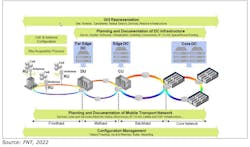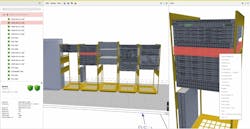Resource Management: A Key Success Factor for 5G Networks
A crucial component of the digital economy is 5G, especially in industrial technologies for industrial Internet of Things (IIoT). Only reliable and fast networking can enable applications with new business models and a high degree of automation. Yet the complexity of operating the hardware infrastructure and the associated software applications continues to increase for mobile operators and communication service providers (CSPs).
Hybrid networks consisting of passive infrastructure, traditional active network components, and increasingly virtualized resources form a complex basis for services and network slices. This hybrid infrastructure, combined with the growing interest in an Open Radio Access Network (Open RAN) strategy and continuous mergers, is placing a particular focus on the need for end-to-end resource management.
Current challenges in 5G networks
With increasing frequency, especially in the millimeter-wave range, 5G networks have physically decreasing ranges. To offset this, the number of transmitting and receiving stations must increase significantly to achieve appropriate network coverage. For mobile network operators or operators of 5G-based corporate networks, this significantly increases the number of locations with the respective devices and antennas, network connections, as well as servers and software installations, which are to be rolled out and put into operation as efficiently as possible in the shortest possible time and with a high degree of automation.
With the rollout of 5G networks, the trend of relying on an Open RAN to enable more interoperability among the components in the RAN is becoming increasingly established. This opening of the RAN in mobile networks breaks the lock-in to one manufacturer within a RAN domain and can thus ensure faster innovation by means of a diverse ecosystem in addition to lowering costs through competition. However, this approach also increases the diversification and the number of devices from different manufacturers that need to be managed. This is why a vendor-agnostic inventory and resource management solution that maps the current and planned state of physical, logical, and virtual network resources end-to-end like a digital twin has become increasingly important.
Last but not least, numerous takeovers and mergers in the communications industry mean that the respective network landscape is typically heterogeneous in terms of manufacturers and technologies used. A digital twin of network resources is the basis for efficiently operating such a heterogeneous network landscape and planning extensions or changes. It also forms an ideal basis for taking over the various network areas in a structured manner in the event of a merger and integrating them into the processes.
Gaining a complete overview of resources
Along with the introduction of 5G, an enormous transformation is also taking place for mobile operators. While virtualization is already widely used in the mobile core, it is now also increasing significantly in the RAN area. Networks are becoming increasingly hybrid as more and more virtual resources are being added to the physical assets of the active and passive infrastructure components. At the same time, the number of locations and the number of systems are growing significantly. This hybrid network infrastructure consists of the following resources:
- Physical resources: antennas, radio units (RUs), and other physical 5G equipment at mobile sites
- Data center infrastructure: edge and core data centers, with racks, power, and cooling equipment
- Logical telco resources: fronthaul, midhaul, and backhaul connections
- IT resources: servers, server clusters, platforms, and storage
- Virtual resources: clouds, virtual machines, containers, virtualized baseband units, and multi-access edge computing (MEC) applications
- Resource-facing services: network slices for IoT, augmented reality, etc.
Only operators who have a complete overview of all resources can carry out proper planning. In the past, many of the problems CSPs have had with the utilization and expansion of their networks were a result of inadequate documentation. Whether companies have their resource management under control determines the success or failure of their 5G expansion.
Planning of new locations
For 5G, mobile operators need a significantly higher number of RAN sites with active and passive components that need to be planned and documented. Resource management can therefore already play a decisive role in site acquisition. For example, when a provider searches for possible site candidates in the vicinity of the desired geo-coordinates for a new site, various information is collected to carry out an evaluation and selection. All of this data can be stored in a structured way in a resource management database for later use. After setting up the site, the data will be centrally available for further planning and operation via a simple status change.
Orchestration and automation
A successful automation strategy requires accurate and consistent resource and inventory data linked to the higher-level management and orchestration systems. To support this initiative, the resource and inventory data must be cross-domain and dynamically updated by the active network wherever possible. Any inaccuracies and gaps in the inventory can lead to errors, costly rework, and time-consuming rescheduling, therefore preventing an efficient and automated rollout. A complete inventory data acquisition of all active and passive components and resources in the network is the first step towards achieving automation.
The importance of unified resource management
Overall, unified resource management is the basis for the planning, rollout, and operation of a 5G network. It’s also crucial in the acquisition of new mobile sites and forms the basis for the planning and execution of the rollout. But also the operation of a hybrid 5G network infrastructure as well as any kind of automation and orchestration makes a cross-domain and always up-to-date resource management indispensable.
For example, as an open RAN increases diversification and the number of manufacturers on the network, an inventory and resource management solution that maps the hybrid network structures with all dependencies and relations from the RAN and edge through the network to the core data center like a digital twin becomes increasingly important.
Meanwhile, mergers and acquisitions are quite often also triggers to start the introduction of such platforms. If unified network resource management is available, it facilitates and accelerates the merging of the different network areas and technologies.
When looking for a unified resource management solution, consider the following features and capabilities:
- Near-real-time synchronization between the database and all active network resources
- A central, end-to-end repository for all active and passive infrastructure with all physical, virtual, and logical resources
- A variety of open interfaces for integration with higher-layer management, control, and orchestration systems that interact with – and make decisions based on – the unified database foundation
- A high level of configuration options to support customer-specific data and processes and to prevent vendor lock-in.
Ulrich Schälling is vice president, market strategy at FNT Software. In this role, he is responsible for the strategy of FNT’s software products in the telecommunications, data center, and IT markets. Before joining FNT, he worked in various roles at Alcatel-Lucent in the OSS and system integration business. Schälling holds a Master’s degree in electrical engineering and has over 30 years of experience in the communications market.
About the Author
Ulrich Schälling
Vice President, Market Strategy, FNT Software
Ulrich Schälling is vice president, market strategy at FNT Software. In this role, he is responsible for the strategy of FNT’s software products in the telecommunications, data center, and IT markets. Before joining FNT, he worked in various roles at Alcatel-Lucent in the OSS and system integration business. Schälling holds a Master’s degree in electrical engineering and has over 30 years of experience in the communications market.


